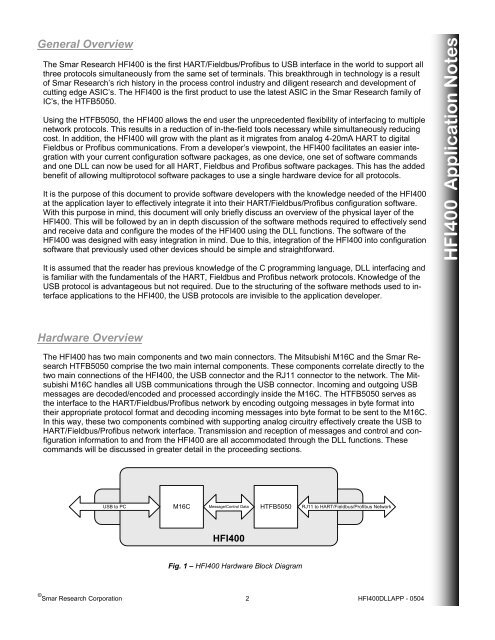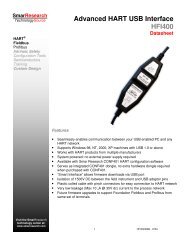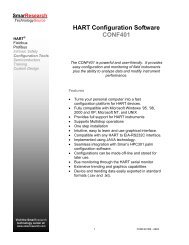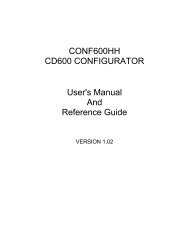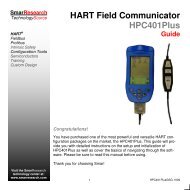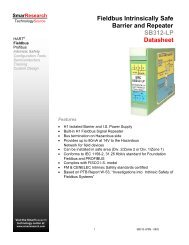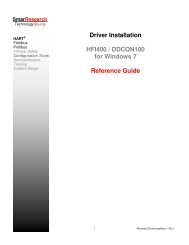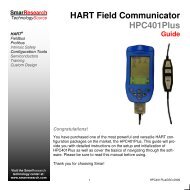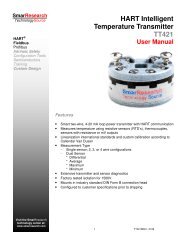HFI400 Software Development Application Notes - smarresearch
HFI400 Software Development Application Notes - smarresearch
HFI400 Software Development Application Notes - smarresearch
You also want an ePaper? Increase the reach of your titles
YUMPU automatically turns print PDFs into web optimized ePapers that Google loves.
General Overview<br />
The Smar Research <strong>HFI400</strong> is the first HART/Fieldbus/Profibus to USB interface in the world to support all<br />
three protocols simultaneously from the same set of terminals. This breakthrough in technology is a result<br />
of Smar Research’s rich history in the process control industry and diligent research and development of<br />
cutting edge ASIC’s. The <strong>HFI400</strong> is the first product to use the latest ASIC in the Smar Research family of<br />
IC’s, the HTFB5050.<br />
Using the HTFB5050, the <strong>HFI400</strong> allows the end user the unprecedented flexibility of interfacing to multiple<br />
network protocols. This results in a reduction of in-the-field tools necessary while simultaneously reducing<br />
cost. In addition, the <strong>HFI400</strong> will grow with the plant as it migrates from analog 4-20mA HART to digital<br />
Fieldbus or Profibus communications. From a developer’s viewpoint, the <strong>HFI400</strong> facilitates an easier integration<br />
with your current configuration software packages, as one device, one set of software commands<br />
and one DLL can now be used for all HART, Fieldbus and Profibus software packages. This has the added<br />
benefit of allowing multiprotocol software packages to use a single hardware device for all protocols.<br />
It is the purpose of this document to provide software developers with the knowledge needed of the <strong>HFI400</strong><br />
at the application layer to effectively integrate it into their HART/Fieldbus/Profibus configuration software.<br />
With this purpose in mind, this document will only briefly discuss an overview of the physical layer of the<br />
<strong>HFI400</strong>. This will be followed by an in depth discussion of the software methods required to effectively send<br />
and receive data and configure the modes of the <strong>HFI400</strong> using the DLL functions. The software of the<br />
<strong>HFI400</strong> was designed with easy integration in mind. Due to this, integration of the <strong>HFI400</strong> into configuration<br />
software that previously used other devices should be simple and straightforward.<br />
It is assumed that the reader has previous knowledge of the C programming language, DLL interfacing and<br />
is familiar with the fundamentals of the HART, Fieldbus and Profibus network protocols. Knowledge of the<br />
USB protocol is advantageous but not required. Due to the structuring of the software methods used to interface<br />
applications to the <strong>HFI400</strong>, the USB protocols are invisible to the application developer.<br />
<strong>HFI400</strong> <strong>Application</strong> <strong>Notes</strong><br />
Hardware Overview<br />
The <strong>HFI400</strong> has two main components and two main connectors. The Mitsubishi M16C and the Smar Research<br />
HTFB5050 comprise the two main internal components. These components correlate directly to the<br />
two main connections of the <strong>HFI400</strong>, the USB connector and the RJ11 connector to the network. The Mitsubishi<br />
M16C handles all USB communications through the USB connector. Incoming and outgoing USB<br />
messages are decoded/encoded and processed accordingly inside the M16C. The HTFB5050 serves as<br />
the interface to the HART/Fieldbus/Profibus network by encoding outgoing messages in byte format into<br />
their appropriate protocol format and decoding incoming messages into byte format to be sent to the M16C.<br />
In this way, these two components combined with supporting analog circuitry effectively create the USB to<br />
HART/Fieldbus/Profibus network interface. Transmission and reception of messages and control and configuration<br />
information to and from the <strong>HFI400</strong> are all accommodated through the DLL functions. These<br />
commands will be discussed in greater detail in the proceeding sections.<br />
USB to PC<br />
M16C<br />
Message/Control Data<br />
HTFB5050<br />
RJ11 to HART/Fieldbus/Profibus Network<br />
<strong>HFI400</strong><br />
Fig. 1 – <strong>HFI400</strong> Hardware Block Diagram<br />
© Smar Research Corporation 2 <strong>HFI400</strong>DLLAPP - 0504


